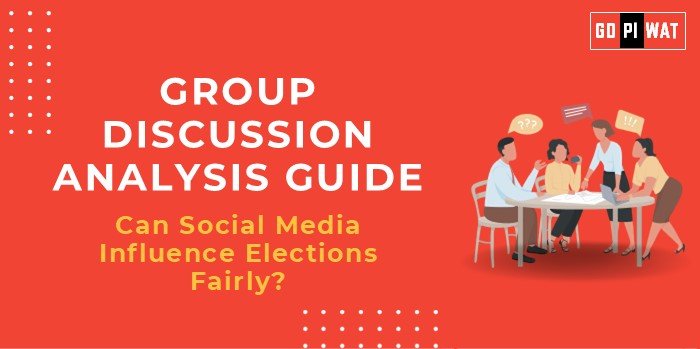📋 Group Discussion (GD) Analysis Guide: Can Social Media Influence Elections Fairly?
🌐 Introduction to the Topic
- 📖 Opening Context: Social media has revolutionized communication, becoming a pivotal tool in modern democracies. Its influence on elections, from voter engagement to political campaigns, raises questions about its fairness and impartiality.
- 🌍 Topic Background: The integration of social media into electoral processes began in the early 2010s, with platforms like Facebook and Twitter serving as tools for campaigning and voter outreach. However, controversies such as data manipulation and the spread of misinformation have highlighted potential biases and ethical concerns.
📊 Quick Facts and Key Statistics
- 🌐 Global Social Media Users: Approximately 4.9 billion users as of 2023, indicating the vast influence of social platforms.
- 💰 Digital Political Ad Spend in the U.S.: Over $3 billion was spent on digital political ads during the 2022 midterm elections.
- ⚠️ Misinformation Spread: Studies indicate that false news spreads more rapidly on social media than factual news.
- 📱 India’s Smartphone Penetration: Over 72% of eligible voters use smartphones, highlighting significant social media access.
🤝 Stakeholders and Their Roles
- 🏛️ Government: Regulates platform content to ensure fairness, monitors misinformation, and enforces campaign transparency.
- 🗳️ Political Parties and Candidates: Utilize social media for outreach, targeting, and engagement to influence voter perceptions.
- 💻 Social Media Platforms: Act as intermediaries but face criticism for biased algorithms and inadequate moderation of false content.
- 👥 Voters and Civil Society: Consume and disseminate information; their digital literacy and critical thinking significantly impact election outcomes.
- 📢 Media and Watchdogs: Monitor campaigns for fairness and expose manipulative practices.
🏆 Achievements and Challenges
✨ Achievements:
- ✅ Increased Voter Engagement: Social media platforms have helped bring younger voters into the electoral process, with turnout increases in several countries.
- 💰 Cost-Effective Campaigning: Digital ads and online campaigns reduce traditional campaign costs while reaching larger audiences.
- 📢 Transparency in Governance: Platforms like Twitter and Facebook have enabled direct communication between candidates and voters, bypassing traditional media.
⚠️ Challenges:
- ⚠️ Misinformation Proliferation: The spread of fake news undermines informed decision-making. For example, during the 2016 U.S. elections, misinformation reached millions.
- 📊 Algorithmic Bias: Content curation often amplifies extreme views or certain candidates, impacting election outcomes unfairly.
- 🌍 Global Comparison: While the U.S. faces challenges like fake news, Estonia has effectively leveraged social media while maintaining stringent regulations on misinformation.
📄 Case Study:
- 📌 India’s 2019 Elections: Social media platforms were credited for record voter turnout but were criticized for unregulated political ads and the spread of divisive content.
💡 Structured Arguments for Discussion
- 📢 Supporting Stance: “Social media democratizes information access, empowering underrepresented communities and encouraging voter participation.”
- ❌ Opposing Stance: “Algorithmic manipulation and the prevalence of misinformation on social media undermine free and fair elections.”
- ⚖️ Balanced Perspective: “While social media increases engagement, its unregulated influence poses significant risks to electoral fairness.”
📌 Effective Discussion Approaches
🎯 Opening Approaches:
- 📊 Statistical Impact: “With approximately 4.9 billion global users, social media has transformed elections, but its fairness remains a pressing issue.”
- ⚖️ Contrast Approach: “While social media amplifies voter voices, it also fosters misinformation, posing a dilemma for electoral integrity.”
🔄 Counter-Argument Handling:
- 📋 If criticized for bias, argue for regulatory frameworks to balance platform neutrality.
- 🛠️ Highlight initiatives like Facebook’s fact-checking partnerships during elections.
📚 Strategic Analysis of Strengths and Weaknesses
- 💪 Strengths:
- 📈 High voter outreach at low cost.
- 📢 Real-time communication between candidates and voters.
- ❌ Weaknesses:
- ⚖️ Lack of regulation on political ads and misinformation.
- 📉 Vulnerability to foreign interference and data misuse.
- ✨ Opportunities:
- 🛠️ Development of stricter content moderation algorithms.
- 🤝 Public-private collaborations for fair use of social media in elections.
- ⚠️ Threats:
- 📢 Escalating cyberattacks targeting voter information.
- 🎭 Deepfake technology influencing public opinion unfairly.
🎓 Connecting with B-School Applications
🌐 Real-World Applications:
- 📋 Marketing Strategies: Lessons from social media campaigns can guide consumer behavior strategies in marketing courses.
- 📊 Policy Analysis: Assessing regulatory frameworks aligns with governance and public policy projects.
❓ Sample Interview Questions:
- ❓ “How can policymakers ensure the ethical use of social media in elections?”
- 💡 “Can technology solve the issues of misinformation during elections?”
📈 Insights for Students:
- 📊 Understand the role of data analytics in campaign strategies.
- ⚖️ Explore ethical challenges in technology-driven industries.


